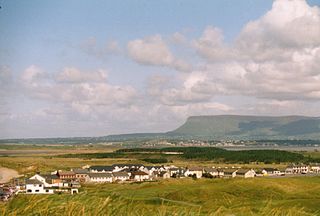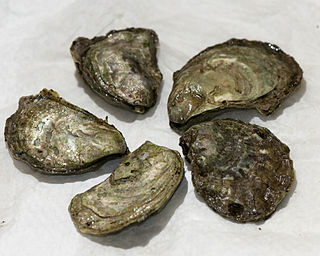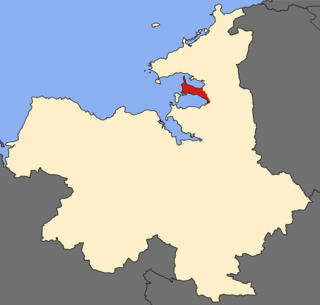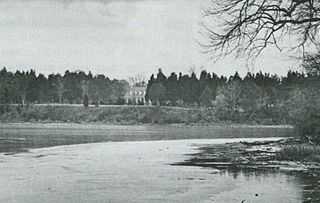
Goold Island is a national park in Queensland, Australia, 1,250 km (780 mi) northwest of Brisbane. The island is close to the northern tip of Hinchinbrook Island off the coast from Cardwell in Rockingham Bay and is part of the Great Barrier Reef World Heritage Area.

Raritan Bay is a bay located at the southern portion of Lower New York Bay between the U.S. states of New York and New Jersey and is part of the New York Bight. The bay is bounded on the northwest by New York's Staten Island, on the west by Perth Amboy, New Jersey, on the south by the Raritan Bayshore communities in the New Jersey counties of Middlesex and Monmouth, and on the east by Sandy Hook Bay. The bay is named after the Raritans, a branch of the Lenape tribe who lived in the vicinity of the bay and its river for thousands of years, prior to the arrival of Dutch and English colonists in the 17th century.

Whaleback Shell Midden is a shell midden, or dump, consisting primarily of oyster shells located on the east side of the Damariscotta River in Maine, United States. It is preserved as a Maine state historic site and was included as part of the Damariscotta Oyster Shell Heaps listed on the National Register of Historic Places in 1969. Other shell middens are located on the estuary in both Damariscotta and Newcastle. The middens in this area were formed over about 1,000 years between 200 BC to AD 1000.

Strandhill or occasionally Larass is a coastal town and townland on the Coolera Peninsula in County Sligo, Ireland. As of 2016, the population was 1,753, an increase of 10% from the 2011 census. The old name appears to be Ros Dragnige.

Fahamore is a townland and small hamlet/village on the Maharees peninsula in County Kerry. It consists of about 50 houses and one pub, Spillane's. Fahamore was historically much more populated than it is now as evidenced by two old schoolhouses in the village, one dating from 1849 and the other from 1911.
Indian Mound Park, also known as Shell Mound Park or Indian Shell Mound Park, is a park and bird refuge located on the northern shore of Dauphin Island, a barrier island of Mobile County, Alabama in the United States. In addition to the many birds which visit, a wide variety of botanical species contribute to the natural offerings. The site is historically significant due to the presence of prehistoric Indian shell middens, mounds composed of discarded oyster shells. The park was added to the National Register of Historic Places on August 14, 1973. It is administered by the Alabama Department of Conservation and Natural Resources.

Horr's Island is a significant Archaic period archaeological site located on an island in Southwest Florida formerly known as Horr's Island. Horr's Island is on the south side of Marco Island in Collier County, Florida. The site includes four mounds and a shell ring. It has one of the oldest known mound burials in the eastern United States, dating to about 3400 radiocarbon years Before Present (BP). One of the mounds has been dated to as early as 6700 BP. It was the largest known community in the southeastern United States to have been permanently occupied during the Archaic period.

The Town of Oyster Bay is the easternmost of the three towns which make up Nassau County, New York, United States. Part of the New York metropolitan area, it is the only town in Nassau County to extend from the North Shore to the South Shore of Long Island. As of the 2020 census, it had a population of 301,332.
The Mark Pardo Shellworks Site is an archaeological site west of Bokeelia, Florida. It is located along the eastern edge of Cayo Costa Island in Cayo Costa State Park. On May 21, 1996, it was added to the U.S. National Register of Historic Places.

The St. Johns culture was an archaeological culture in northeastern Florida, USA that lasted from about 500 BCE until shortly after European contact in the 17th century. The St. Johns culture was present along the St. Johns River and its tributaries (including the Oklawaha River, and along the Atlantic coast of Florida from the mouth of the St. Johns River south to a point east of the head of the St. Johns River, near present-day Cocoa Beach, Florida. At the time of first European contact, the St. Johns culture area was inhabited by speakers of the Mocama, Agua Fresca and Acuera dialects of the Timucua language and by the Mayacas.

Ostrea lurida, common name the Olympia oyster, after Olympia, Washington in the Puget Sound area, is a species of edible oyster, a marine bivalve mollusk in the family Ostreidae. This species occurs on the northern Pacific coast of North America. Over the years the role of this edible species of oyster has been partly displaced by the cultivation of non-native edible oyster species.
The town of Sligo was founded in 1243 AD by the Norman knight Maurice Fitzgerald and Fedlim O'Conchobar the Rí Coiced of Connacht. Norman influence appears to have lasted for about 60 years. From around 1310, after the Gaelic resurgence, the town existed well within the Gaelic cultural zone and developed on the Sligeach (Garavogue) river under the O’Conchobhar Sligigh dynasty and within the Irish túath of Cairbre Droma Cliabh as part of the Gaelic confederation of Iochtar Connacht until the creation of County Sligo by the English Lord Deputy Henry Sidney in 1561.

Sligo Bay is a natural ocean bay in County Sligo, Republic of Ireland.
Takonoura shell midden is an archaeological site consisting of a Jōmon period shell midden and the remains of an adjacent settlement located in what is now the city of Ōfunato, Iwate Prefecture in the Tōhoku region of northern Japan. It has been protected by the central government as a National Historic Site since 1934.

The Rosses Point Peninsula is a small peninsula in the centre of Sligo Bay, County Sligo, Ireland. The peninsula shares its name with the village of Rosses Point, a popular seaside resort located on the peninsula's southern coast, roughly 7.5 km (5 mi) west of Sligo town.

The Coolera Peninsula is a peninsula in Sligo Bay, County Sligo, Ireland. It is the most populous of County Sligo's peninsulas, and the second-largest by land area. The primary population centres on Coolera are the coastal town of Strandhill on its western shore, and Magheraboy, a suburb of Sligo town.
The Roberts Island complex is an archaeological site in Citrus County, Florida, near the Gulf of Mexico, dating from the late Woodland period. It is located on an island in the Crystal River midway between the springs at the head of the river and the mouth of the river on the Gulf of Mexico. The site is a geographically separate unit of the Crystal River Archaeological State Park. The site includes three shell mounds and three middens. Two of the mounds may have had stepped sides. The Roberts Island complex was developed as the Crystal River site declined and most other ceremonial sites in the region were abandoned during the 7th or 8th century.

Te Matuku Bay is a bay on Waiheke Island in New Zealand's Hauraki Gulf. It is one of the largest and least disturbed estuaries on the island. Since 2003, the area has been protected as part of Te Matuku Marine Reserve.

The Kusaka Shell Midden is an archaeological site in the Kusaka neighborhood of the city of Higashiōsaka, Osaka Prefecture, in the Kansai region of Japan containing a Jōmon period shell midden. It was designated a National Historic Site of Japan in 1972.

















